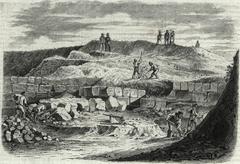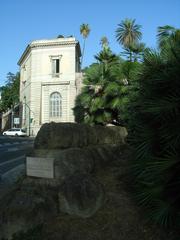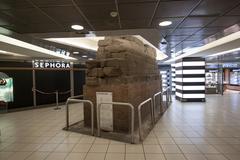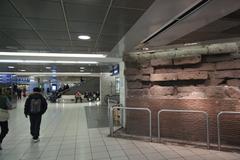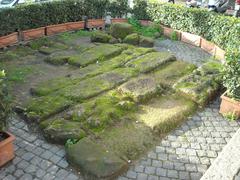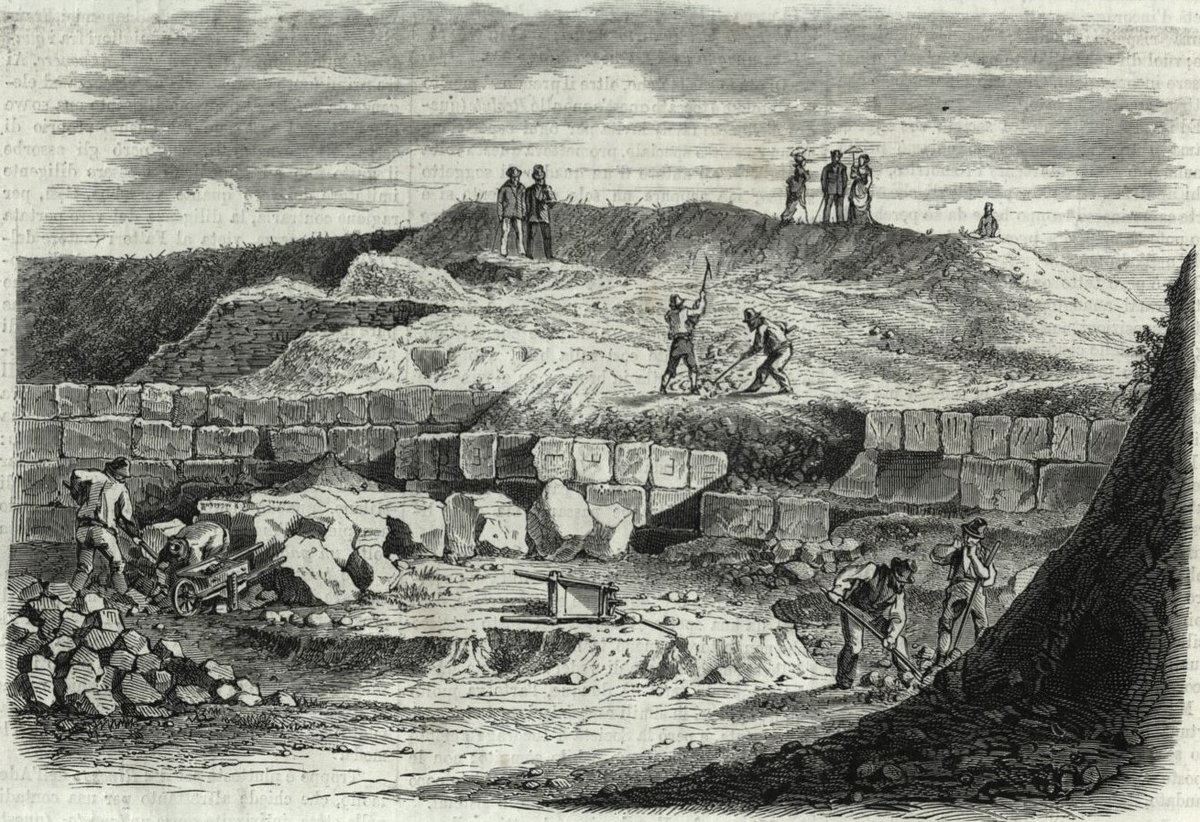
Servian Wall Rome Visiting Hours, Tickets, and Historical Sites Guide
Date: 14/06/2025
Introduction
Nestled amid the modern cityscape of Rome, the Servian Wall stands as a testament to the city’s ancient origins and enduring resilience. Constructed in the early 4th century BCE, this monumental fortification encircled Rome’s famed seven hills, stretching approximately 11 kilometers (about 7 miles). Traditionally attributed to Rome’s sixth king, Servius Tullius, the wall not only served as a formidable defense but also reflected the social and political transformations shaping early Roman society, including pivotal reforms in urban planning and civic inclusion (Ancient Origins; World History Edu).
Crafted from locally quarried volcanic tuff, the wall’s impressive height—up to 10 meters—and substantial thickness (up to 3.6 meters) showcase the advanced engineering techniques of the time, blending Etruscan influences with early Roman innovation (UNRV; Jeff Bondono). More than a mere barrier, its gates connected vital Roman roads, facilitating commerce and communication, while providing the security that fueled Rome’s transformation into a thriving metropolis.
Today, remnants of the Servian Wall remain accessible to the public, especially near Rome’s Termini railway station and Piazza dei Cinquecento, offering a tangible link to the city’s layered history without entrance fees or restrictive visiting hours. Whether explored independently or via guided tours, the wall invites travelers to discover an often-overlooked facet of Rome’s ancient urban fabric, seamlessly integrated into the modern city (Atlas Obscura; Full Suitcase).
This guide explores the Servian Wall’s historical background, architectural features, cultural significance, and practical visitor information, including tips on accessibility, nearby attractions, and photographic opportunities—ensuring you make the most of your journey through one of Rome’s oldest monuments.
Contents
- Introduction: Discover Rome’s Hidden Historical Gem
- The Historical Context of the Servian Wall
- Layout and Dimensions
- Construction Materials and Techniques
- Defensive Features: Gates, Towers, and Urban Integration
- Visiting the Servian Wall: Practical Information
- Travel Tips and Accessibility
- Nearby Attractions
- Photography Recommendations
- FAQ (Frequently Asked Questions)
- Preservation Challenges and Future Prospects
- The Wall’s Significance in Rome’s Urban Identity
- Conclusion and Visitor Recommendations
- References and Further Reading
The Historical Context of the Servian Wall
Rome’s Early Growth and the Need for Fortification
By the 6th century BCE, Rome was evolving from scattered hilltop settlements into a unified city-state. Expansion and growing wealth made the city a target for external threats, prompting the need for robust defenses (Ancient Origins).
Servius Tullius: Visionary King and Social Reformer
Servius Tullius (reigned c. 578–535 BCE) is credited with initiating the wall’s construction. His reign brought military success and sweeping social reforms, including the first Roman census, redistribution of land to the poor, and a broader inclusion of citizens in civic life (Ancient Origins).
Construction and Engineering
Although traditionally attributed to Servius Tullius, archaeological evidence suggests the wall was constructed after the Gallic sack of Rome in 390 BCE, as a response to increased threats (Luxury Travel Diva). Built from volcanic tuff, the wall encircled Rome’s seven hills, with a height of up to 10 meters and a thickness of 3.6 meters (Ancient History Encyclopedia).
Defensive and Strategic Role
Serving as both a practical and symbolic defense, the Servian Wall protected Rome from external attacks and enabled urban expansion. It featured at least 16 gates, connecting major Roman roads and facilitating trade and communication (World History Edu). The wall’s presence contributed to a sense of security, fostering social and economic growth.
Archaeological and Urban Significance
After the wall’s construction, repairs and modifications continued, especially after significant events such as the Gallic sack. Its physical footprint shaped the city’s layout, influencing urban development for centuries (Ancient History Encyclopedia).
Layout and Dimensions
The Servian Wall, or Murus Servii Tullii, stretched approximately 11 kilometers (6.8 miles), enclosing around 245–426 hectares and encompassing all seven hills of ancient Rome (World History Edu; Wikipedia). Its height reached up to 10 meters (33 feet), and its base was about 3.6 meters (12 feet) thick, ranking it among the most impressive urban fortifications of its time (UNRV; Jeff Bondono).
Construction Materials and Techniques
The wall was constructed primarily from blocks of volcanic tuff. Early sections used Cappellaccio tuff from the Alban Hills, while later repairs and expansions incorporated higher-quality Grotta Oscura tuff quarried after the conquest of Veii (Wikipedia; Roman Empire). The tuff blocks were cut and assembled without mortar, a testament to Roman precision and engineering (Jeff Bondono). Limestone was used in some later repairs, further enhancing durability.
Defensive Features: Gates, Towers, and Urban Integration
The Servian Wall was more than a passive barrier:
- Gates: The wall featured at least 16 main gates, including Porta Esquilina (now the Arch of Gallienus), Porta Sanqualis, and Arcus Caelimontani (Jeff Bondono; Wikipedia). These connected the city to major roads such as Via Appia and Via Tiburtina (World History Edu).
- Towers & Ramparts: Towers provided elevated positions for defenders, and some original arches survive near Piazza Albania (UNRV). The wall also featured ramparts and large earth mounds (agger) for additional defense and troop movement (Roman Empire; UNRV).
- Urban Integration: The wall’s circuit closely followed the contours of Rome’s seven hills, using natural cliffs and ravines to enhance defenses and reduce construction effort (Roman Empire).
Visiting the Servian Wall: Practical Information
Location and How to Get There
The most accessible and preserved sections are near Roma Termini Station and Piazza dei Cinquecento. Roma Termini is served by metro lines A and B, multiple bus lines, and regional trains, making it convenient for travelers.
Visiting Hours and Admission
The Servian Wall is an outdoor site integrated with the city’s fabric; visiting hours are unrestricted. Viewing is free of charge, and no tickets are required. Some guided tours or nearby museums may charge admission.
Accessibility
Sections near Termini and Piazza Albania are accessible by wheelchair and stroller, with paved sidewalks and ramps. However, caution is advised in areas with uneven surfaces.
Travel Tips and Accessibility
- Best Times to Visit: Early mornings or late afternoons offer optimal lighting for photography and fewer crowds.
- Accessibility: Most visible sections are accessible on foot and via public transport; some terrain may be uneven.
- Safety: The area around Piazza dei Cinquecento is busy but generally safe; observe standard urban precautions.
Nearby Attractions
Combine your visit with nearby sites such as:
- Baths of Diocletian
- Basilica di Santa Maria Maggiore
- National Roman Museum
- Roman Forum and Colosseum (a short transit ride away)
Many of these landmarks are within walking distance or easily accessible via public transit (Full Suitcase).
Photography Recommendations
For striking photos, visit the wall during golden hour (morning or late afternoon) when the volcanic tuff’s texture is most dramatic. The section near Termini offers a compelling juxtaposition of ancient stonework and modern architecture.
FAQ (Frequently Asked Questions)
Q: Do I need tickets to visit the Servian Wall?
A: No, most visible sections are free and open to the public.
Q: What are the visiting hours?
A: Outdoor sections are accessible 24/7; indoor segments (like in Termini’s McDonald’s) follow the venue’s operating hours.
Q: Is the Servian Wall wheelchair accessible?
A: Yes, especially the main section near Termini and the indoor segment within the station.
Q: Can I join a guided tour?
A: Yes, several walking tours of ancient Rome include the Servian Wall (Full Suitcase).
Q: What other historical sites are nearby?
A: Baths of Diocletian, National Roman Museum, Basilica di Santa Maria Maggiore, and more.
Preservation Challenges and Future Prospects
Urban development, pollution, and tourism exert pressure on the wall’s fragmented remains (mmdtkw.org). Integrating the wall into public and commercial spaces has improved visibility and access, but ongoing conservation is vital.
The Wall’s Significance in Rome’s Urban Identity
The Servian Wall is more than an archaeological relic; it’s woven into Rome’s living urban fabric. Its adaptive reuse—in places like train stations and restaurants—demonstrates Rome’s unique blend of antiquity and modernity, sparking ongoing discussions about conservation and urban development (Atlas Obscura).
Conclusion and Visitor Recommendations
The Servian Wall offers a rare opportunity to connect with the foundational layers of Rome’s history. Its enduring stones recall the city’s evolution from a cluster of settlements into a powerful urban center, embodying the ingenuity and resilience of early Romans. Free, accessible, and surrounded by other historic treasures, the wall is a must-see for anyone interested in Rome’s ancient past.
For a richer experience, consider downloading the Audiala app for maps, audio guides, and curated itineraries. Stay updated on Rome’s historical sites by following related articles and social media channels.
References and Further Reading
- Servius Tullius and the Servian Wall, Ancient Origins, 2024
- Servian Wall, Ancient History Encyclopedia, 2024
- The Servian Wall in Rome, World History Edu, 2024
- Servian Wall, Wikipedia, 2024
- Servian Wall, UNRV History, 2024
- Servian Wall, Jeff Bondono’s Tourist in Rome, 2024
- How Did the Servian Wall Contribute to the Development of Rome?, Luxury Travel Diva, 2024
- Different Things to Do in Rome, Full Suitcase, 2024
- Servian Wall at McDonald’s, Atlas Obscura, 2024
- Walls of Rome, mmdtkw (Mark’s Medieval and Renaissance History Site), 2024
